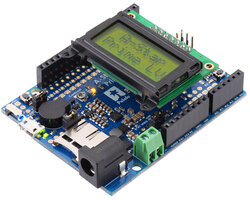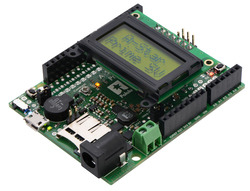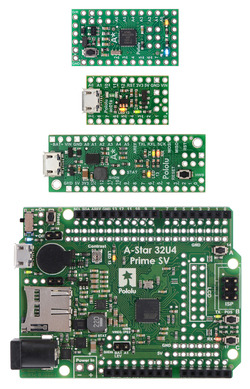The A-Star 32U4 Prime LV is a programmable board based on the ATmega32U4 AVR microcontroller and arranged in the common Arduino form factor.
Special Order
Shipping from $9.90
+50 more from our supplier in 7-10 days
Our Code: SKU-005390
Supplier Link: [Pololu MPN:4007]
The A-Star 32U4 Prime LV is a programmable board based on the ATmega32U4 AVR microcontroller and arranged in the common Arduino form factor. The A-Star Prime offers many additional features and improvements over competing products, including superior power management that enables efficient operation from 2 V to 16 V (though it requires at least 3 V at start-up). This configuration of the A-Star 32U4 Prime LV has no microSD support and includes preinstalled female headers common to many Arduinos.
The Pololu A-Star 32U4 Prime is a general-purpose programmable board based on the ATmega32U4 AVR microcontroller from Microchip (formerly Atmel) and arranged in the common Arduino form factor exemplified by the Uno R3 and Leonardo. As such, the A-Star Prime (abbreviated A* Prime) is compatible with many Arduino shields, including all of the Arduino shields we carry. All 26 of the microcontroller’s GPIO lines are accessible on the board, including seven than can be used as PWM outputs and twelve that can be used as analogue inputs. The ATmega32U4 is capable of native full-speed USB, which makes it more versatile than similar boards that rely on USB-to-serial adapters: in addition to supporting a virtual (CDC) serial/COM port interface, the A-Star can appear to a connected computer as a mouse and keyboard. The A-Star’s USB interface can be accessed through its USB Micro-B connector.
The A* Prime supports the on-board microcontroller with many additional features and improvements over competing products, including enhanced connectivity and superior power management. The Prime is available in two main versions: LV, which features a blue solder mask and a step-up/step-down voltage regulator that allows operation from 2 V to 16 V, and SV, which features a green solder mask and a switching step-down regulator that allows operation from 5 V to 36 V. Each version is available in several different configurations: with or without preinstalled through-hole components like standard Arduino female headers and with or without microSD support. There is also a configuration available for each version with an 8×2 character LCD.
  |
A-Star 32U4 Prime LV microSD with LCD. |
|---|
A-Star 32U4 Prime LV (2 V to 16 V) configurations:
  |
A-Star 32U4 Prime SV microSD with LCD. |
|---|
A-Star 32U4 Prime SV (5 V to 36 V) configurations:
We carry an A-Star Prime accessory pack that contains an assortment of parts you might want when assembling the configurations without preinstalled headers (items #4005, #4006, #3111, and #3112).
Our comprehensive user’s guide provides the basics you need to get started with the A-Star as well as detailed technical information for advanced users.
This product requires a USB A to Micro-B cable (not included) to connect to a computer.
This configuration of the A-Star 32U4 Prime LV does not offer microSD support and is assembled with through-hole components as shown in the picture above so that all the basic features can be used without any additional soldering. The standard female headers common to many Arduinos are preinstalled, as is the 2×3 male ISP header, buzzer, DC power jack, and shorting block headers for enabling the buzzer and battery voltage monitor. This is the LV version of the A-Star Prime, which operates from 2 V to 16 V.
This newer version (ac03e) of the A-Star 32U4 Prime LV replaces the original version (ac03b). The new version uses an improved 5 V regulator that can deliver more current and operates from 2 V to 16 V instead of 2.7 V to 11.8 V. The easiest way to distinguish between the two versions is via the silkscreen on the bottom side of the board, above and to the left of the Pololu logo, where the original version is labelled ac03b and the new version is labelled ac03e.
A major feature of the A* Prime LV is its power system, which allows it to efficiently operate from a 2 V to 16 V external source. The input voltage is regulated to 5 V by a TPS630701 switching step-up/step-down (buck-boost) converter from Texas Instruments. (We also make a standalone regulator based on this integrated circuit.) The regulator’s flexibility in input voltage is especially well-suited for battery-powered applications in which the battery voltage begins above 5 V and drops below 5 V as the battery discharges. Without the typical restriction on the battery voltage staying above 5 V throughout its life, a wider range of battery types can be considered. For example:
As shown in the left graph below, the LV’s 5 V switching regulator has an efficiency – defined as (Power out)/(Power in) – of 80% to 90% for most combinations of input voltage and load.
Note that the maximum available output current from the 5V pin is 1.9 A, which is limited by the power MUX. To achieve the higher output currents shown in the graphs above, you must connect to the VREG pin to bypass the power MUX and access the regulator directly.
The A-Star’s components, including the microcontroller and LEDs, draw 30 mA to 40 mA in typical applications (without the buzzer, microSD card, or an LCD). The rest of the regulator’s achievable output current, which depends on input voltage as well as ambient conditions, can be used to power other devices. The blue line in the right graph above shows output currents at which the voltage regulator’s over-temperature protection typically kicks in after a few seconds. These currents represent the limit of the regulator’s capability and cannot be sustained for long periods; under typical operating conditions, a safe limit for the maximum continuous regulator output current is 60% to 70% of the values shown in the graph.
The A-Star 32U4 Prime ships with a preloaded Arduino-compatible bootloader (which uses 4 KB of flash memory, leaving 28 KB available for the user program). We provide a software add-on that enables the board to be easily programmed from the Arduino environment and an Arduino library to make it easy to use the additional on-board hardware. The A-Star 32U4 has the same microcontroller and form factor as the Arduino Leonardo, and it runs at the same frequency, so we generally expect it to work with shields that are compatible with the Leonardo and similar boards. Note that the Prime has additional components and connection points, so you should make sure these do not physically interfere with any shield you are considering using. The following table shows how the Prime compares to the Leonardo and Uno:
 Arduino Uno R3 |
 Arduino Leonardo |
 A-Star 32U4 Prime LV |
 A-Star 32U4 Prime SV |
||
|---|---|---|---|---|---|
| Microcontroller: | ATmega328P | ATmega32U4 | ATmega32U4 | ||
| Clock: | 16 MHz resonator | 16 MHz crystal | 16 MHz crystal | ||
| User I/O lines: | 20 | 23 | 26 | ||
| PWM outputs: | 6 | 7 | 7 | ||
| Analogue inputs: | 6 | 12 | 12 | ||
| Ground access points: | 4 | 4 | 43 | ||
| User LEDs: | 3 | 3 | 3 | ||
| User pushbuttons: | — | — | 3 | ||
| Reset button: |  |
 |
 |
||
| Power switch: |  |
||||
| Buzzer option: |  |
||||
| microSD option: |  |
||||
| LCD option: |  |
||||
| Arduino-compatible bootloader: |
 |
 |
 |
||
| USB connector: | B | Micro-B | Micro-B | ||
| USB/regulator power selection: |
partial | partial | TPS2113A | ||
| High-performance reverse-voltage protection: |
 |
||||
| Recommended input voltage: |
7 V to 12 V | 7 V to 12 V | 2 V to 16 V | 5 V to 36 V | |
| Regulator type (5 V): | linear | linear | switching step-up/step-down |
switching step-down |
|
| Available 5 V output current: |
at 3 V in | — | — | 0.75 A | — |
| at 5 V in | — | — | 1.5 A | 0.2 A | |
| at 7 V in | 1.0 A | 1.0 A | 1.9 A(1) | 1.0 A | |
| at 9 V in | 0.5 A | 0.5 A | 1.9 A(1) | 1.0 A | |
| at 11 V in | 0.35 A | 0.35 A | 1.8 A | 1.0 A | |
| at 24 V in | — | — | — | 1.0 A | |
| via USB connector |
0.5 A(2) | 0.5 A(2) | 1.9 A(3) | 1.9 A(3) | |
| Weight: | 28 g | 20 g | 13 g to 33 g | ||
| Price: | $27.60 | $24.95 | $33.40 to $53.00 | ||
| 1 There is more available 5 V output current via VREG, see maximum regulator output current graph for details. | |||||
| 2 With sufficient USB power supply. | |||||
| 3 Nominal current available through power MUX with sufficient USB power supply. | |||||
  |
From top to bottom: A-Star 328PB Micro, 32U4 Micro, 32U4 Mini SV, and 32U4 Prime SV. |
|---|
The A-Star 32U4 Micro is a part of our larger A-Star family, all of whose members are based on AVR microcontrollers and are preloaded with Arduino-compatible bootloaders. The table below shows some key features and specifications of our A-Star microcontroller boards to help you choose the right one for your application.
 |
   |
  |
  | ||
|---|---|---|---|---|---|
| A-Star 328PB Micro | A-Star 32U4 Micro | A-Star 32U4 Mini ULV A-Star 32U4 Mini LV A-Star 32U4 Mini SV |
A-Star 32U4 Prime LV A-Star 32U4 Prime SV |
A-Star 32U4 Robot Controller LV A-Star 32U4 Robot Controller SV |
|
| Microcontroller: | ATmega328PB | ATmega32U4 | |||
| User I/O lines: | 24 | 18 | 26 | 26(1) | 26(1) |
| Available PWM outputs: | 9 | 6 | 7 | 7 | 7(1) |
| Analogue inputs: | 8 | 8 | 12 | 12 | 12(1) |
| Ground access points: | 6 | 2 | 4 | 43 | 44 |
| User LEDs: | 1 | 2 | 3 | 3 | 3 |
| User pushbuttons: | — | — | — | 3 | 3 |
| USB interface: |  |
 |
 |
 |
|
| Reset button: |  |
 |
 |
 |
|
| Power switch: |  |
 |
|||
| Buzzer option: |  |
 |
|||
| microSD option: |  |
||||
| LCD option: |  |
||||
| Motor drivers: |  |
||||
| Operating voltage: | 3.3V VCC: 3.8 V to 15 V 5V VCC: 5.5 V to 15 V |
5.5 V to 15 V | ULV: 0.5 V to 5.5 V LV: 2.7 V to 11.8 V SV: 5 V to 40 V |
LV: 2 V to 16 V SV: 5 V to 36 V |
LV: 2.7 V to 11 V SV: 5.5 V to 36 V |
| Regulator type: | 3.3 V or 5 V linear | 5 V linear | 5 V switching ULV: step-up LV: step-up/step-down SV: step-down |
5 V switching LV: step-up/step-down SV: step-down |
5 V switching LV: step-up/step-down SV: step-down |
| Regulated current:(2) | 100 mA | 100 mA | ULV: 500 mA LV: 1 A SV: 800 mA |
LV: 1.8 A SV: 1 A |
LV: 1 A SV: 1.5 A |
| Dimensions: | 1.3″ × 0.7″ | 1″ × 0.6″ | 1.9″ × 0.7″ | 2.8″ × 2.1″ | 2.6″ × 2.2″ |
| Weight: | 1.5 g(3) | 1.3 g(3) | 3.4 g(3) | 13 g to 33 g | 14 g to 23 g |
| Price: | $11.72 | $19.95 | $29.95 to $29.95 | $33.40 to $53.00 | $39.05 to $54.84 |
| 1 Some microcontroller resources are used by on-board hardware. | |||||
| 2 These values are rough approximations for comparison purposes. Available current depends on input voltage, current consumed by the board, ambient conditions, and regulator topology. See product documentation and performance graphs for details. | |||||
| 3 Without included optional headers. | |||||
| Size: | 2.8″ × 2.1″ (common Arduino form factor) |
|---|---|
| Weight: | 19 g |
| Processor: | ATmega32U4 @ 16 MHz |
|---|---|
| RAM size: | 2560 bytes |
| Program memory size: | 32 Kbytes1 |
| Motor channels: | 0 |
| User I/O lines: | 26 |
| Input voltage range: | 2 V to 16 V (LV) |
| Minimum operating voltage: | 2 V2 |
| Maximum operating voltage: | 16 V |
| Maximum output current: | 1.8 A3 |
| Logic voltage: | 5 V |
| Reverse voltage protection?: | Y |
| External programmer required?: | N |
| Version: | includes no microSD support and preinstalled female headers |
| PCB dev codes: | ac03e |
|---|---|
| Other PCB markings: | 0J11918 |
User’s manual for the Pololu A-Star 32U4 family of user-programmable boards.
Printable pinout and power distribution diagrams of the A-Star 32U4 Prime (applies to both LV and SV versions).
This download contains the Windows drivers for the A-Star 32U4 and the rest of our 32U4 family of boards.
Printable schematic diagram of the A-Star 32U4 Prime LV.
This DXF drawing shows the locations of all of the board’s holes.
The AStar32U4 library for the Arduino IDE helps interface with the on-board hardware on the A-Star 32U4 controllers.
This repository contains Arduino add-on files, Windows drivers, and bootloaders for the A-Star 328PB, A-Star 32U4, and the rest of our 32U4 family of boards.
Arduino integrated development environment (IDE) software
Microchip’s product page for the ATmega32U4 AVR microcontroller, with links to its datasheet, application notes, and other resources.
The web site for AVR Libc, which is the standard library of functions that you can use with C and C++ on the AVR.
The A-Star and Orangutan discussion section of the Pololu Robotics Forum.
AVR community with forums, projects, and AVR news.
AVRDUDE is a cross-platform command-line utility for programming the flash memory on AVR microcontrollers.
LUFA is an embedded software library written in C that can be used to create USB applications on USB-capable AVRs. It comes with a large library of example USB applications and bootloaders.
A free integrated development environment (IDE) for AVRs. Formerly known as Atmel Studio.
A free, open-source suite of development tools for the AVR family of microcontrollers, including the GNU GCC compiler for C/C++.
This is a library for the Arduino that interfaces with our LPS22DF, LPS25HB, LPS25H, and LPS331AP pressure/altitude sensor carriers as well as the pressure sensors on the various AltIMU-10 modules, which can be found here. It makes it simple to read the raw pressure data from the sensor, and it provides functions to help calculate altitude based on the measured pressure.
This library allows you to control an arbitrary number of SK6812/WS281x-Based Addressable RGB LEDs from an Arduino.
This is a library for the Arduino that interfaces with our LSM303D, LSM303DLHC, and LSM303DLM 3D compass and accelerometer carriers as well as the compass and accelerometer ICs on the MinIMU-9 v3 and AltIMU-10 v4 (it also works with older versions of those boards, some of which used the LSM303DLH and LSM303DLHC). It makes it simple to configure the device and read the raw accelerometer and magnetometer data, and it has a function for computing the tilt-compensated heading for those looking to use the LSM303 as a tilt-compensated compass.
This is a library for the Arduino that interfaces with our L3GD20H and L3GD20 3-axis gyro carriers as well as the gyros on the MinIMU-9 v3 and AltIMU-10 v3 (it also works with older versions of those boards, some of which used the L3G4200D and the L3GD20). It makes it simple to configure the device and read the raw gyro data.
This guide explains how to use the QTRSensors library to read Pololu QTR reflectance sensors and QTR sensor arrays with Arduinos and Arduino-compatible devices like the Pololu Orangutan robot controllers.